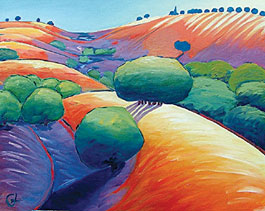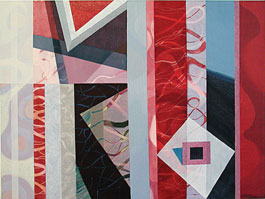home | metro silicon valley index | the arts | visual arts | preview

Rolling Hills: Gary Coleman's California landscapes seem to move with bright, surreal colors.
From the Artist's Eye
Silicon Valley Open Studios gives more than 350 artists a chance to strut their strokes
By Marianne Messina
FOR ABSTRACT painter Sydell Lewis, who's painted all her life, painting is "a need, and it's a joy," and she believes the world would be a lot more peaceful "if everybody did creativity." If Lewis' theory is correct, the sheer number of artists—more than 350 spread over three weekends—in this year's 20th anniversary Silicon Valley Open Studios would suggest that the Bay Area is well on its way to world peace.
Fond of experiment, Lewis belongs to the Gallery House in Palo Alto, one of the three cooperative galleries in this year's Open Studios, because "commercial galleries, once you get in on a certain thing that you're doing, that's it. That's what they want you to do."
Painter Gary Coleman has no problem working under the pressures of the market. "The money part isn't too important," he says, "but I kind of like keeping score." Known for his rolling California hills rendered with a distinct sense of motion in bright, surreal colors, Coleman can report, "I've had the good fortune to be selling them faster than I can paint them."
But as he looks down at a favorite, where the hills are more abstract and the shadows are purple, he admits the 3-year-old painting is not likely to sell. The message he gets from buyers is "I want what you do, not what you did."
In fact, if you visit Coleman's works at the Pacific Art League in Palo Alto, you'll find his most abstract paintings facing the wall like naughty children. In one painting, the bold reds, blues, blacks are full of energy, wild dashes of paint that erupt here and there as recognizable bits—fingers on a partial guitar neck, for example. "It has something to do with sound," he says as he contemplates the painting.
Unlike this piece and many others in his studio, Coleman feels that the painting with the purple shadows is complete. "The thing that makes that painting work is the freedom."
Talk among these Open Studios artists reflects a continual process of negotiating their relationship to freedom: freedom vs. order, the individual's freedom to express vs. the demands of the collective viewer. In this, perhaps, the artist's challenge does start to look like the struggle for world peace.
Painter Hongyun Suriwong (who shows in Mountain View the first weekend and in San Jose the second) has had a more literal experience of this struggle. Born and raised in China, Suriwong's artistic training forced her to be a perfectionist and a realist. "We used to be graded on how real our work looked," she recalls.
And then one day she met her future husband in a park in Shanghai, an American, and everything changed. In the beautifully romantic but sometimes painful whirlwind of change that brought her to marry and live in America, Suriwong stopped painting. Bombarded in her new home by the wide-open field of Western artistic styles, she wondered if she might have to abandon her career forever: "I started to question the nature of art. I've seen many things that would not pass as art in China be considered great art in the Western world." But finally, she picked up the brush again. "I started to let myself experiment with my brush strokes."
And four years later, Suriwong paints brides in traditional Asian costume. Her most recent of these colorful, evocative paintings, Lhasa Sunset, reflects her sense of romance around the culture of Tibet. "Tibet is like my dreamland. I have never been there, but I know that it is one of the few places on earth that is still pure."
Suriwong's traditional images are not something she brought from her homeland, where "white weddings" (with Western-style dress) are the norm, and the party line on Tibet casts it as a province of rebel clerics who live in opulence and sponge off the poor. Only in America did she see the films set in ancient Asian cultures that sparked her imagination and her current passion: to preserve the inspirational beauty of traditional cultures.

A Need and a Joy: Sydell Lewis' 'On a Complex Note' is influenced by Pop art.
Suriwong experienced the traditional wedding for herself when she married in Thailand in a ceremony complete with elephants and nine monks to kneel and pray to. Like Coleman and Lewis, Suriwong found artistic freedom in the abstract. In her current in-progress painting (working title, The Red Veil), the vision of the veiled bride materializes through stabs of near-black ("Black in weddings is a bad thing") and deep reds (for good luck) like a ghost. "You can say that when I was learning to paint, I painted for my teachers, but now I create art for myself."
But not everyone finds a sense of freedom in the abstract. Aldo Lira, who shows in Mountain View, enjoys working in the style of old masters like Raphael. His imagination is caught more by a narrative—the hero, the mystery—and he updates classic themes by replacing halos and angelic beings with luminous objects and the suggestion of alien entities. Characteristically, Lira's paintings draw the eye to striking pockets of light.
Using a similar classical lighting sensibility, Iona Ezaki's paintings also draw the eye. An anthologized artist whose Western landscapes have landed her a commission to paint a wall mural just outside Yellowstone Park, Ezaki finds comfort in the detail and realism that Suriwong feels as "a pressure." For this reason, Ezaki (who exhibits in Saratoga) calls herself a "tight" painter, and her artistic growth has brought her not to the abstract but to the art of painting on location. "The first time I went out, I had a hard time," Ezaki says. "I didn't want to do it because I want to control my strokes and plan them, and when you're outdoor painting, you have to let all of that go."
Perhaps it is this quest of the creative person for artistic growth (if, in fact, growing pains stir global conflict) that advances Sydell Lewis' creativity = equation. Lewis herself can fluidly churn a conflicting perspective into her work, which incorporates ideas inspired by Op artist Victor Vasarely, "keeping your eye shifting on the canvas, keeping the whole surface of the canvas really energetic."
Once told by a patron that her painting was "upside down," Lewis found herself envisioning a new series, The Balancing Act: Paintings That Rotate. Fixing each of these new paintings—striated patterns on a vertical—to a rotating wall mount, Lewis plans to kick off her co-op's Open Studios offering on Friday night, May 5 (the Gallery House at Printer's Inc. Cafe in Palo Alto) with a piece of performance art. Lewis takes on this new medium by accompanying the rotation of her paintings with a poetic reading. Risk, courage, innovation—smells like world-peace spirit.
Silicon Valley Open Studios runs May 6-7 in northern Santa Clara County, May 13-14 in southern Santa Clara County and May 20-21 in San Mateo County and along the coast. For details, see www.svos.org.
Send a letter to the editor about this story.
|
|
|
|
|
|